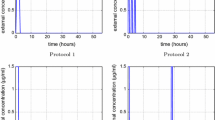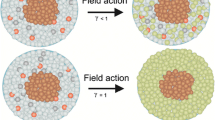Abstract
We propose a spatially distributed continuous model for the spheroid response to radiation, in which the oxygen distribution is represented by means of a diffusion-consumption equation and the radiosensitivity parameters depend on the oxygen concentration. The induction of lethally damaged cells by a pulse of radiation, their death, and the degradation of dead cells are included. The compartments of lethally damaged cells and of dead cells are subdivided into different subcompartments to simulate the delays that occur in cell death and cell degradation, with a gain in model flexibility. It is shown that, for a single irradiation and under the hypothesis of a sufficiently small spheroid radius, the model can be reformulated as a linear stationary ordinary differential equation system. For this system, the parameter identifiability has been investigated, showing that the set of unknown parameters can be univocally identified by exploiting the response of the model to at least two different radiation doses. Experimental data from spheroids originated from different cell lines are used to identify the unknown parameters and to test the predictive capability of the model with satisfactory results.
Similar content being viewed by others
References
Araujo, R.P., McElwain, D.L.S., 2004. A history of the study of solid tumour growth: the contribution of mathematical modelling. Bull. Math. Biol. 66, 1039–1091.
Bertuzzi, A., d’Onofrio, A., Fasano, A., Gandolfi, A., 2003. Regression and regrowth of tumour cords following single-dose anticancer treatment. Bull. Math. Biol. 65, 903–931.
Bertuzzi, A., Fasano, A., Gandolfi, A., Sinisgalli, C., 2008. Reoxygenation and split-dose response to radiation in a tumour model with Krogh-type vascular geometry. Bull. Math. Biol. 70, 992–1012.
Bristow, R.G., Hill, R.P., 1998. Molecular and cellular basis of radiotherapy. In: Tannock, I.F., Hill, R.P. (Eds.), The Basic Science of Oncology, pp. 295–321. McGraw-Hill, New York.
Casciari, J.J., Sotirchos, S.V., Sutherland, R.M., 1992. Variations in tumor cell growth rates and metabolism with oxygen concentration, glucose concentration, and extracellular pH. J. Cell. Physiol. 151, 386–394.
Darzynkiewicz, Z., Juan, G., Li, X., Gorczyca, W., Murakami, T., Traganos, F., 1997. Cytometry in cell necrobiology: analysis of apoptosis and accidental cell death (necrosis). Cytometry 27, 1–20.
d’Onofrio, A., 2007. Rapidly acting antitumoral antiangiogenic therapies. Phys. Rev. E Stat. Nonlinear Soft Matter Phys. 76, 031920.
Düchting, W., Ulmer, W., Lehrig, R., Ginzberg, T., Dedeleit, E., 1992. Computer simulation and modelling of tumour spheroid growth and their relevance for optimization of fractionated radiotherapy. Strahlenter. Onkol. 168, 354–360.
Düchting, W., Ginzberg, T., Ulmer, W., 1995. Modeling of radiogenic responses induced by fractionated irradiation in malignant and normal tissue. Stem Cells 13, 301–306.
Evans, S.M., Labs, L.M., Yuhas, J.M., 1986. A cellular automaton model for tumour growth in inhomogeneous environment. Int. J. Radiat. Oncol. Biol. Phys. 12, 969–973.
Freyer, J.P., 1988. Role of necrosis in regulating the growth saturation in multicellular spheroids. Cancer Res. 48, 2432–2439.
Freyer, J.P., Sutherland, R.M., 1985. A reduction in the in situ rates of oxygen and glucose consumption of cells in EMT6/Ro spheroids during growth. J. Cell. Physiol. 124, 516–524.
Freyer, J.P., Sutherland, R.M., 1986. Regulation of growth saturation and development of necrosis in EMT6/Ro multicellular spheroids by the glucose and oxygen supply. Cancer Res. 46, 3504–3512.
Hlatky, L.R., Hahnfeldt, P., Sachs, R.K., 1994. Influence of time-dependent stochastic heterogeneity on the radiation response of a cell population. Math. Biosci. 122, 201–220.
Jostes, R.F., Williams, M.E., Barcellos-Hoff, M.H., Hoshino, T., Deen, D.F., 1985. Growth delay in 9L rat brain tumor spheroids after irradiation with single and split doses of X rays. Radiat. Res. 102, 182–189.
Kalman, R.E., Falb, P.L., Arbib, M.A., 1969. Topics in Mathematical System Theory. McGraw-Hill, New York.
Montalenti, F., Sena, G., Cappella, P., Ubezio, P., 1998. Simulating cancer cell kinetics after drug treatment: application to Cisplatin on ovarian carcinoma. Phys. Rev. E 57, 5877–5887.
Mueller-Klieser, W., 1984. Method for the determination of oxygen consumption rates and diffusion coefficients in multicellular spheroids. Biophys. J. 46, 343–348.
Mueller-Klieser, W., 1987. Multicellular spheroids. a review on cellular aggregates in cancer research. J. Cancer Res. Clin. Oncol. 113, 101–122.
Papa, F., 2009. Models of the tumour spheroid response to radiation: identifiability analysis. Technical report N. 9/2009, Dipartimento di Infomatica e Sistemistica, Sapienza University of Rome.
Rofstad, E.K., Wahl, A., Brustad, T., 1986. Radiation response of multicellular spheroids initiated from five human melanoma xenograft lines. relationship to the radioresponsiveness in vivo. Br. J. Radiol. 59, 1023–1029.
Sachs, R.K., Hahnfeld, P., Brenner, D.J., 1997. The link between low-let dose-response relations and the underlying kinetics of damage production/repair/misrepair. Int. J. Radiat. Biol. 72, 351–374.
Sena, G., Onado, C., Cappella, P., Montalenti, F., Ubezio, P., 1999. Measuring the complexity of cell cycle arrest and killing of drugs: kinetics of phase-specific effects induced by taxol. Cytometry 37, 113–124.
Shinomiya, N., 2001. New concepts in radiation-induced apoptosis: ‘premitotic apoptosis’ and ‘postmitotic apoptosis’. J. Cell. Mol. Med. 5, 240–253.
Simeoni, M., Magni, P., Cammia, C., De Nicolao, G., Croci, V., Pesenti, E., Germani, M., Poggesi, I., Rocchetti, M., 2004. Predictive pharmacokinetic-pharmacodynamic modeling of tumor growth kinetics in xenograft models after administration of anticancer agents. Cancer Res. 64, 1094–1101.
Sutherland, R.M., 1988. Cell and environment interactions in tumor microregions: the multicell spheroid model. Science 240, 177–184.
Thames, H.D., 1985. An ‘incomplete-repair’ model for survival after fractionated and continuous irradiations. Int. J. Radiat. Biol. 47, 319–339.
Travis, C.C., Haddock, G., 1981. On structural identification. Math. Biosci. 56, 157–173.
Ubezio, P., Cameron, D., 2008. Cell killing and resistance in pre-operative breast cancer chemotherapy. BMC Cancer 8, 201.
Wein, M.L., Cohen, E.J., Wu, J.T., 2000. Dynamic optimization of a linear-quadratic model with incomplete repair and volume-dependent sensitivity and repopulation. Int. J. Radiat. Oncol. Biol. Phys. 47, 1073–1083.
Wouters, B.G., Brown, J.M., 1997. Cells at intermediate oxygen levels can be more important than the ‘hypoxic fraction’ in determining tumor response to fractionated radiotherapy. Radiat. Res. 147, 541–550.
Zacharaki, E.I., Stamakos, G.S., Nikita, K.S., Uzunoglu, N.K., 2004. Simulating growth dynamics and radiation response of avascular tumour spheroids—model validation in the case of an EMT6/Ro multicellular spheroid. Comput. Methods Programs Biomed. 76, 193–206.
Author information
Authors and Affiliations
Corresponding author
Rights and permissions
About this article
Cite this article
Bertuzzi, A., Bruni, C., Fasano, A. et al. Response of Tumor Spheroids to Radiation: Modeling and Parameter Estimation. Bull. Math. Biol. 72, 1069–1091 (2010). https://doi.org/10.1007/s11538-009-9482-y
Received:
Accepted:
Published:
Issue Date:
DOI: https://doi.org/10.1007/s11538-009-9482-y




